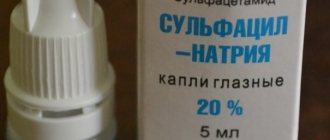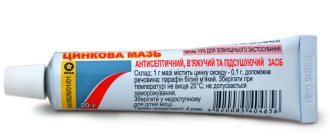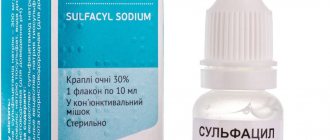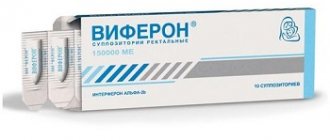Immediately after birth, newborns begin to experience many changes in their bodies. They are associated with the development of organs, the rearrangement of certain functions, and the cleansing of everything unnecessary. Of course, this also applies to the baby’s eyes. But not everything always goes the way nature intended. Sometimes failures occur, and the child is not able to cope with the problem without the help of parents and doctors. Thus, Vitabact for newborns will help solve some ophthalmological problems.
Directions for use and dosage regimen
The drug should be instilled into children carefully, securely fixing the child so as not to damage the eyes.
The drug is used 4 times a day, by instillation into the conjunctival sac. Usually the course of treatment is about 5-7 days. For congenital dacryocystitis, the course of treatment can be extended to 3-4 weeks, before probing.
For children under three years of age, putting drops into the eyes can be quite difficult. Sometimes this procedure requires two people at once - dad holds the baby's head, and mom drips drops.
The technique of instilling drops is quite simple: with the thumb of the left hand, the lower eyelid is pushed downwards, thereby opening the conjunctival sac, and 1-2 drops of the drug are instilled with the right hand.
Action
The drug has an effective antimicrobial effect. This is the main function of these drops and they are allowed to be used to treat small children. Young patients are exposed to germs more often and more frequently.
It is particularly effective in the treatment of inflammatory and infectious lesions that occur in the eyes. The effect of the drug is noted on inflammatory and infectious processes caused by E. coli, pathogenic cocci, chlamydia and other types of fungi, as well as viruses.
Vitabact eye drops for children and newborns
Vitabact eliminates the spread of pathological microflora in the eye area. The medicine is approved for infants and newborns.
The medicine is available without a prescription. In addition to bacterial infections, the product also eliminates dacryocystitis.
The active substance is picloxidine. To prevent the development of side effects, it is necessary to comply with the dosage and regimen of use of the drug.
More information about the drug can be found here
After surgery
Before surgery, Vitabact is administered 1 drop several hours before surgery. During the rehabilitation period, the medicine is prescribed 1 drop into the organs of vision. Instillations are carried out 3 to 4 times a day.
Prevention of viral conjunctivitis
After contact with a patient with conjunctivitis, Vitabact can be instilled as a preventive measure. In this case, the child is prescribed 1 or 2 drops per day. The frequency of application is from 2 to 3 times. For prevention, the medicine is instilled for 3 days.
Interaction with other drugs
Drug interactions between the drug and other medications have not been studied. The interval between instillations should be at least 15 minutes to prevent the development of negative manifestations.
Side effects
The drug is well tolerated. In rare cases, allergic manifestations are possible:
- increased tear production;
- hyperemia;
- itching sensation;
- swelling;
- short-term blurred vision.
If such symptoms develop in patients of a younger age category, it is necessary to discontinue the medication.
Contraindications
For children, instillation of Vitabact is prohibited if they are individually intolerant to the components of the medicine. There are no other contraindications to the use of the medication for this category of patients.
Olga Anatolyevna, ophthalmologist: I prescribe medication to prevent infection with conjunctivitis in children. In kindergartens and schools, no one is immune from this pathology, since there is a high density of children in these places.
At the first suspicion of the development of viral conjunctivitis, a few drops of Vitabact will not only reduce the likelihood of infection, but also act as an additional prevention of bacterial damage to the organs of vision. I also prescribe the medication to infants up to one year old in the presence of dacryocystitis.
However, treating this disease with Vitabact takes quite a long time.
Before possible surgical intervention, I prescribe the drug for 3 days to prevent complications due to surgery. I advise all mothers to give their child 1 drop of medication after visiting particularly crowded places.
But you should not overuse the medicine, as it may lose its effectiveness.
Victoria: We used Vitabact after kindergarten, since everyone there got sick with conjunctivitis. With the help of the medicine, my daughter was able to prevent infection. I recommend it to other mothers for prevention for their children.
Sasha: The drug was instilled into the eyes after removing foreign particles from my son’s eye. Used it for about 3 days. No side effects were observed.
Shelf life and storage
After the date of manufacture, the medicine is suitable for use for 2 years. After the first opening, the shelf life is reduced to 30 days. After this period, the product should be disposed of. Do not allow children to use the product independently.
Vitabact eliminates not only the pathology itself, but also acts as a preventive measure against infection. The medicine has a minimum of side effects, which indicates its safe use by children. Before first use, it is advisable to check for allergies to the components of the medication.
Poor vision significantly worsens the quality of life and makes it impossible to see the world as it is.
Not to mention the progression of pathologies and complete blindness.
MNTK "Eye Microsurgery" published an article on non-surgical restoration of vision up to 90%, this became possible thanks to...
Read more Was this article helpful?
Rate the material on a five-point scale! (2 1.50
Side effects
The use of drops is usually well tolerated if the patient does not violate the dosage recommendations and rules of use.
Negative reactions are rare and are mainly due to an individual reaction to the components of the medication. When administering drops to a child or adult, the following side effects may develop:
- an unpleasant burning sensation in the eyes, causing you to rub them vigorously and blink more than usual;
- excessive tearing;
- the appearance of a feeling as if there is a foreign body in the eye;
- change in color of the mucous membrane of the eye to bright red.
Although Vitabact for newborns is used in ophthalmology, parents should carefully monitor the child when using the drug. If your baby is bothered by unwanted side effects, you should definitely consult a doctor. In some cases, the side effects of the medication are so pronounced that you have to stop using it.
Instructions for use for infants
According to the instructions for use, the duration of the therapeutic course for staphylococcal infection does not exceed 7 days. For streptococcus, treatment is extended to 10 days.
Dosage
Depending on the diagnosis, the drug is used 2 to 4 times a day. According to indications, the solution can be dripped every 2 hours. 1 drop is instilled into the conjunctival sac.
After surgical procedures, the medicinal solution is used 3-4 times a day. For preventive purposes, Vitabact is dripped in the morning and evening, 1 drop into each eye.
Mode of application
Algorithm for eye drops in newborns:
Prepare sterile cotton swabs or gauze pads, a warm solution of furatsilin 1:5000 (dissolve 1 tablet with a dosage of 20 mg in 100 ml of hot water). Place the baby on a diaper on the changing table. Rinse eyes from pus and crusts with prepared disinfectant solution
To do this, moisten a swab generously in furatsilin and carefully rinse the eye in the direction from the outer corner to the inner one. To clean the second eye, take a new sterile swab. Open the bottle with Vitabact drops; you can preheat it by holding it in your palm. Place your right hand with a dropper bottle on the child’s forehead
This way you can fix the head so that the baby does not spin, which will prevent accidental damage to the cornea by the tip. The bottle must be held at an angle of 40° during instillation, this will help avoid eye injuries. The tip should not touch the mucous membrane or skin. Use a cotton swab to pull down the lower eyelid and release 1 drop.
Contraindications and side effects
Vitabact is contraindicated in case of individual intolerance to the components.
Signs that determine high sensitivity to the drug in infants:
- sharp redness of the conjunctiva;
- swelling of the eyelids;
- pale facial skin;
- cardiopalmus;
- unstable act of inhalation and exhalation.
Vitabact for topical use is well tolerated by children. But it can cause allergic reactions in babies. Sensitivity to the drug is due to the physiological characteristics of the conjunctiva. In infants, the drug enters the systemic bloodstream through the mucous membrane and can affect the functioning of internal organs.
Sometimes the following allergic reactions develop:
- burning, itching, conjunctival hyperemia;
- swelling of the eyelids, peeling of the skin around the eyes;
- urticaria, allergic dermatitis;
- rhinitis, shortness of breath.
The child becomes restless, constantly cries, refuses to feed, and often wakes up during sleep.
Levomycetin
Drops with a broad antibacterial effect, produced in Russia.
The basis is an antibiotic.
It is prescribed to children in extreme cases, in the absence of results from the therapy.
The use of the drug is contraindicated during pregnancy.
Distinctive features:
- Low cost, available in any pharmacy chain.
- Effective against bacterial resistance to penicillin, tetracycline and sulfonamide series.
- The downside is the frequent occurrence of side effects.
- With long-term (more than 2 weeks) use, inhibition of hematopoietic function is noted.
- In some cases, Levomycetin can cause secondary fungal infection of the eyes.
This is the cheapest analogue - the price is about 20 rubles.
Antibacterial drops. The active ingredient is the antibiotic tobramycin.
Effective for purulent inflammations, quickly stops the growth of microorganisms and destroys them.
They have low adsorption, do not have a systemic effect on the body and are excreted by the kidneys in an almost unchanged state.
Compared to Vitabact:
- They have a broader and more powerful effect on pathogenic flora.
- Effective when bacteria are resistant to other antibacterial groups.
- Able to penetrate into mother's milk, therefore contraindicated during pregnancy.
- Like any antibiotic, Tobrex disrupts the natural microflora. Long-term use causes the development of a fungal infection.
- Despite the fact that the manufacturer allows the use of the drug in childhood, doctors prescribe it only in extreme cases.
Cost – about 180 rubles.
Used as a substitute for Vitobact.
The active ingredient is ofloxacin.
Has the same indications as Vitabact.
In addition, it is prescribed for traumatic eye injuries for preventive purposes.
Pros and cons of the drug:
- Wide antimicrobial spectrum, low resistance of microorganisms to ofloxacin.
- Approved for use for children from birth.
- Increases the sensitivity of the mucous membrane, so during therapy you should protect your eyes from exposure to sunlight.
- Side effects from using Floxal occur a little more often, but in general the drug has the same properties and results as Vitobact.
The price of drops is 180 rubles.
Pharmacological group
The drug represents a pharmacological group of antiseptics for local use in ophthalmic practice. The main active ingredient of the drug picloxidine is a chemical derivative of biguanides. It has antiseptic activity and leads to the death of a significant number of microorganisms, which include bacteria (staphylococci, streptococci, chlamydia, proteus, Escherichia coli, Pseudomonas aeruginosa, Shigella, bacilli), as well as some types of viruses and fungi.
After instillation, systemic absorption of the active component of the drug remains at a minimal level.
Compound
The composition of any medicinal product or drops is very important:
- Firstly, by studying the composition you can immediately warn your baby against health problems. It is necessary to take into account the individual characteristics of the child. Many babies are especially sensitive to some components of the medicine from the first days of life.
- Secondly, the components contained in the drops will not always be able to help the baby and solve the problem . Any organism, both children's and adult's, may not accept the components included in the composition of the medicine.
Vitabact includes a component such as picloxidine dihydrochloride . This is the main component, acting as an active substance, on the basis of which this drug functions and directly affects the organ of vision.
As with any other drug, Vitabact contains auxiliary components, on the basis of which the active component works.
VITABAKT
Release form, composition and packaging
◊ Eye drops
in the form of a clear, colorless or slightly yellowish solution.
| 1 ml | |
| picloxidine dihydrochloride | 500 mcg, |
| which corresponds to the content of picloxidine | 434 mcg |
Excipients: anhydrous dextrose (glucose) - 50 mg, polysorbate 80 - 0.25 mg, purified water - up to 1 ml.
10 ml - polyethylene dropper bottles (1) - cardboard packs.
pharmachologic effect
A drug with an antimicrobial effect, a derivative of biguanides.
Active regarding
Staphylococcus aureus, Streptococcus faecalis, Escherichia coli, Eberthella typhosa, Klebsiella pneumoniae, Proteus vulgaris, Shigella dysenteriae, Bacillus subtilis, Chlamydia trachomatis; some viruses and fungi.
Indications
Adults and children from 0 years:
- bacterial infections of the anterior part of the eye;
- dacryocystitis;
- prevention of infectious complications in the postoperative period after surgical interventions in the anterior eye region.
Dosage
In the treatment of bacterial infections
the drug is instilled into the conjunctival sac, 1 drop 2-6 times a day. The duration of treatment is 10 days, the feasibility and need to extend the treatment period beyond 10 days is determined by the doctor.
- In the postoperative period,
the drug is instilled into the conjunctival sac, 1 drop 3-4 times a day. - To prevent postoperative complications
(preoperative preparation), 1-2 drops of the drug are instilled into the conjunctival sac immediately before surgery. - Rules for using the drug
Vitabact eye drops are available in a sealed polyethylene bottle with a dropper; no pipettes are required for instillation. To open the bottle, you need to screw the cap all the way, and the spike on its inside should pierce the dropper.
To instill eye drops, it is necessary to tilt the patient's head back a little, the patient's gaze should be directed upward
The drug is instilled into the lower conjunctival sac, carefully retracting the lower eyelid
To prevent contamination of the drug solution during instillation, patients should avoid contact of the dropper tip with the eye and skin.
Rarely:
allergic reactions in the form of conjunctival hyperemia.
Drug interactions
If it is necessary to instill several drugs into the conjunctival sac, the drugs should be used separately with an interval of at least 15 minutes.
special instructions
- Vitabact eye drops should not be used for subconjunctival injections or administered into the anterior chamber of the eye.
- Vitabact eye drops do not change the color of contact lenses (including soft hydrophilic ones), however, in case of infectious eye diseases, wearing contact lenses is contraindicated.
- Impact on the ability to drive vehicles and operate machinery
- If vision clarity decreases during treatment with the drug, patients should stop driving vehicles and operating machinery.
Pregnancy and lactation
Since the use of the drug during pregnancy and lactation has not been studied, Vitabact is not recommended for pregnant and lactating women.
Storage conditions and periods
The drug should be stored out of the reach of children at a temperature of 15°C to 25°C. Shelf life: 2 years. Do not use after expiration date.
After opening the bottle, the drug should be used within 1 month.
The description of the drug VITABAKT is based on the officially approved instructions for use and approved by the manufacturer.
Found an error? Select it and press Ctrl+Enter.
special instructions
The drug is effective and considered safe. Eye drops are approved for use in children under one year of age and adults. Children are prescribed in dosages of 10% and 20%.
INTERESTING: the best eye drops for children over one year old
For adolescents over 14 years of age, the concentration of the active substance is 30%. If necessary, prescribed to pregnant and lactating women. Before use, be sure to consult a doctor.
Albucid for newborns
The components of the drug do not irritate the delicate mucous membrane of the baby's eyes. Drops can be used in infants if necessary. If there is a risk of infection of a newborn with blenorrhea, use strictly according to the instructions, two drops of Albucid in each eye immediately after birth. After 2 hours, the steps are repeated.
Blennorea is a gonococcal infection. A predisposition to the disease in an infant is the presence of gonococci in the mother's tests. The danger of infection occurs when passing through the birth canal. In case of infection, serious consequences for the baby are possible - decreased vision, blindness. In this case, Albucid is used for the treatment and prevention of severe infection.
Is it possible to use Albucid for prophylactic purposes?
Prophylactic use for newborns is justified if there is a risk of the baby becoming infected with gonococcal infection (blennorrhea). Infants and older children can receive the drug in case of ophthalmic bacterial diseases in family members.
Sometimes drops are prescribed for preventive purposes during the recovery period after surgery and to neutralize the effects of injuries. In other cases, prophylactic use is not advisable.
Vitabact eye drops for children - instructions
Vitabact eye drops are a medicine that is used for preventive and therapeutic purposes of inflammatory diseases of the organ of vision of a bacterial, viral and fungal nature. The drug has a pronounced antiseptic and antimicrobial effect. It contains no preservatives, which makes it possible to prescribe drops for the treatment of very young patients.
Composition, release form
The bactericidal substance picloxidine dihydrochloride (500 mcg) is the active component of Vitabact ophthalmic drops. The additional ingredients are:
- emulsifier - polysorbate 80;
- natural monosaccharide – dextrose (anhydrous);
- purified water.
Vitabact eye drops for newborns, children and adults are a colorless liquid solution for topical use. Packaged in plastic transparent dropper bottles of 10 ml. Each cardboard package contains 1 tube of solution and detailed instructions for use.
pharmachologic effect
The active ingredient picloxidine gives the drug a powerful antiseptic and disinfectant effect. Due to this, the antimicrobial effect of Vitabact eye drops is manifested. They are active against most gram-positive and gram-negative bacteria:
- streptococci (lat. Streptococcus);
- staphylococci (lat. Staphylococcaceae);
- shigella (lat. Shigella);
- chlamydia (lat. Chlamydia), etc.
Some pathogenic viruses and fungi are sensitive to the medication. The antiseptic destroys the membrane of bacterial cells, leading to their death.
Systemic absorption is extremely negligible when applied topically.
Side effects, overdose
Drops when applied topically are well tolerated by patients. Undesirable consequences may occur only in rare cases. A feeling of discomfort, burning, redness, hyperemia of the eye mucosa are reactions that go away on their own a few minutes after the procedure and do not require therapy.
The absence of side effects allows the use of Vitabact drops for the treatment of newborns.
No cases of overdose have been identified. If you accidentally swallow an ophthalmic solution, take any sorbent and call an ambulance.
Drug interactions
There are no restrictions on the use of Vitabact drops with other medications. Combining different groups of drugs for treatment does not lead to any significant interaction.
If therapy includes the use of several local eye medications, then it is necessary to wait at least 15 minutes between instillation of other ophthalmic drops.
General recommendations
Vitabact eye drops are contained in a hermetically sealed polyethylene bottle with a built-in dropper pipette. Before the first use, you need to screw the cap all the way, which will help the special spike pierce the dropper.
The procedure must be carried out carefully, without touching the tip of the pipette to the mucous membrane, eye skin or other surfaces. This is necessary to prevent infection of the dropper and the treatment solution itself.
It is strictly forbidden to inject the product into the anterior chamber of the eye or use it for subconjunctival injections.
Read more Pirenoxin eye drops: instructions for use and reviews
It is recommended to remove the contact device before instillation. You can put on lenses 20-30 minutes after the procedure.
During the treatment period, it is advisable to refrain from wearing any contact lenses (hard, soft), because
Some people experience decreased vision clarity after instillation. Such patients should avoid driving a car and operating complex machinery for a short period of time. Usually the unpleasant symptom goes away on its own within a few minutes.
Shelf life, storage conditions
The shelf life of the drug is 2 years from the production date indicated on the cardboard box. After opening the bottle, the ophthalmic solution is suitable for use for one month.
Store the bottle of medicine in its original packaging, out of the reach of children, where the temperature is 15-25°C.
Conditions for dispensing from pharmacies
Vitabact drops are dispensed from pharmacies without presenting a prescription from a doctor.
The cost of Vitabact in Russia is in the range of 280-350 rubles. The price depends on the region and the pharmacy chain that sells the drops.
Analogs
In ophthalmology, there are many medications that are analogues of Vitabact in terms of application. Drops designed to combat bacterial infections are available on the market in a wide range. For example:
- Dancil is an antimicrobial drug. The main active ingredient is ofloxacil, which helps fight bacteria. It can be used not only for eye diseases, but also if there are pathologies of the ears. The average price is 150-160 rubles.
- Oftadek is another antimicrobial drug in which the active ingredient is decamethoxin. Has a bactericidal effect on microorganisms. Can additionally be used to perform aseptic processing of lenses. The cost is within 80 rubles.
- Signicef is a medicine whose main active ingredient is the antibiotic levofloxacin, which has an antimicrobial effect. The drug is used if the sensitivity of the identified microorganisms to levofloxacin is proven. The average cost ranges from 230 to 250 rubles.
- Oftaquix is another eye drop that contains levofloxacin. Indications for use are similar. The price ranges from 250 to 270 rubles.
There are other analogues of Vitabact that can be found in pharmacies. If the patient doubts that the drug is on sale in his city, he should find out in advance what can replace it. It is prohibited to independently replace Vitabact with analogues.
The medicine for eye infections Vitabact is a drug that has proven itself in the fight against various diseases. A significant advantage is that it is safe for newborns.
Instructions for use
Before using Vitabact eye drops, let us read the instructions for use in more detail. Adult patients suffering from a bacterial infection need to place 1-2 drops in each eye. The minimum duration of therapy is 10 days. The number of instillations is determined individually
The patient’s condition and age are taken into account. Usually 2 to 6 instillations per day are prescribed.
If an acute course of the disease is observed, the dose may be maximum. After improvement, the treatment regimen is adjusted, the volume of the drug and the number of instillations. The duration of treatment ranges from 7-10 days. If the symptoms do not go away, the treatment regimen is changed. In some cases, a different medicine is prescribed.
Patients who have undergone eye surgery are prescribed 1-2 drops 3 times a day. Preventive instillations must be carried out for 3 days. In some cases, a single use of the product is prescribed before the operation. When contacting a patient suffering from keratitis or conjunctivitis, prescribe 1-2 drops in each eye at a time.
Adult patients can self-administer the drug. The main thing is to treat your hands with bactericidal soap. The procedure can be performed either sitting or lying on your back. However, the head should be thrown back and the gaze should be directed upward.
Mode of application
For infectious eye diseases in adults, Tsipromed is instilled 1-2 drops into both eyes. The procedure algorithm is simple, but requires compliance with important nuances:
- Prepare everything you need - a bottle of medicine, a cotton pad or a disposable paper napkin.
- Wash your hands thoroughly with soap and dry them.
- Remove the cap. When the vial is first opened, the edges of the dropper are sealed. There is no need to cut off the plastic tip with scissors. Simply turn the bottle cap counterclockwise and the sharp needle in the cap will pierce a hole. It's simple and convenient.
- Tilt your head back a little.
- Bring the bottle to the inner corner of your open eye. Try not to touch the tip of the dropper to the mucous membrane, eyelids or eyelashes.
- Direct your gaze upward, and with the fingers of your free hand, slightly pull down the lower eyelid.
Place 1 drop of antibiotic into each conjunctival sac.
- Gently press the sides of the bottle and squeeze one drop of the medicine into the eye. If you're not sure it's in the right place, drop it one more time.
- Close your eyes for 2-3 minutes. Do not squeeze your eyelids as this will cause the medication to come out.
- Repeat the same with the other eye.
The frequency of the procedure and the duration of the course of treatment are determined individually, depending on the disease.
| Indications | Frequency of instillation | A course of treatment | |
| Acute conjunctivitis, acute blepharitis (simple, ulcerative or scaly) | 4-8 r/day | 5-14 days | |
| Keratitis | Caused by Pseudomonas aeruginosa | 8-12 r/day | 2-3 weeks |
| Caused by other pathogens | 6-10 r/day | 14-30 days | |
| Bacterial corneal ulcer |
| 10-14 days (until the ulcer heals) | |
| Anterior uveitis | 8-12 r/day | 10-14 days | |
| Dacryocystitis Canaliculitis | Spicy | 6-12 r/day | Until clinical recovery (on average 10-28 days) |
| Chronic | 4-8 r/day | ||
| Prevention of secondary infection | For eyeball injuries | 4-8 r/day | 1-2 weeks |
| During operations on the organ of vision | 4-6 r/day | 5-30 days |
If you wear hard contact lenses, be sure to remove them before instillation. You can put them on again no earlier than after 15 minutes.
Therefore, during treatment, ophthalmologists recommend temporarily replacing lenses with glasses.
Official instructions prohibit the use of Tsipromed for the treatment of newborns and infants under 1 year of age. This contraindication is associated with the absorption (albeit insignificant) of ciprofloxacin into the bloodstream and a possible negative effect on the child’s body.
For children over 1 year of age, schoolchildren and adolescents, the drug is prescribed without restrictions. The dosage, frequency and duration of administration are the same as for adults.
Another option for using Tsipromed in childhood is instillation into the nose. Being an antibiotic, the product easily copes with the causes and symptoms of bacterial rhinitis. In this case, the pediatrician draws up a regimen for using drops individually, taking into account the patient’s age, the characteristics of the course of rhinitis and the presence of concomitant diseases.
Elena (son Fedor, 4 years old):
It was convenient to drip the solution; my son tolerated the procedure calmly and did not complain of burning, itching or other unpleasant sensations. I noticed an improvement by the evening of the same day: there was less purulent discharge from the eye, and the redness subsided.
Terms of use
If the patient's eyelashes and eyelids are stuck together with pus, you first need to clean them with a cotton swab dipped in a strong tea leaves or an antiseptic solution (chamomile decoction, for example). Boiled water cooled to room temperature will also work.
An important rule: for each eye there is a separate swab and a separate container with liquid. When opening the bottle for the first time, screw the cap all the way - then the spike located on its inside will pierce the spout of the container
When opening the bottle for the first time, screw the cap all the way - then the spike located on its inside will pierce the spout of the container.
When instilling, tilt your head back and look up
Then gently pull back the lower eyelid and drop the required amount of medicine under it. To prevent liquid from flowing through the nasal passage into the oral cavity, close the eyelid and lightly press it with your finger at the bridge of the nose
Typically, 1-2 drops of medication are prescribed in each eye 2-6 times a day.
Always start with the healthy or least inflamed eye. Make sure that the tip of the dropper does not touch the surface of the apple to avoid mechanical injury and contamination of the solution.
If any other eye medications are prescribed, the interval between instillations should be at least 15 minutes to prevent leaching of the medicinal composition.











